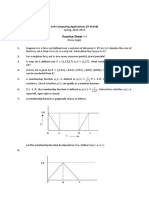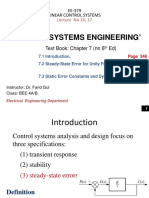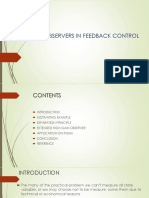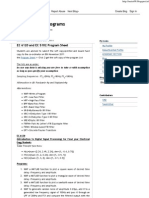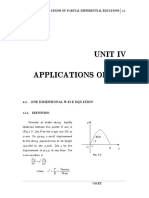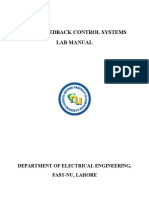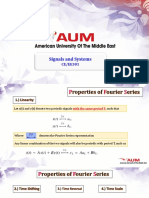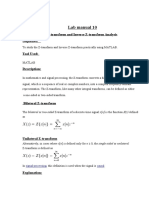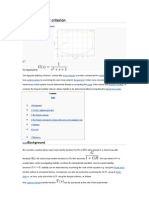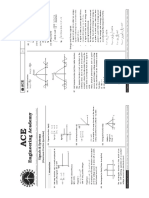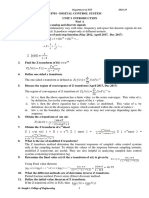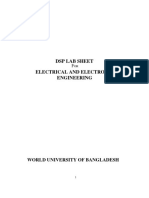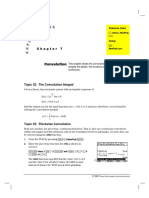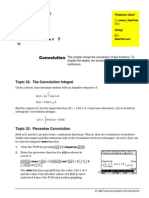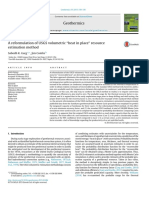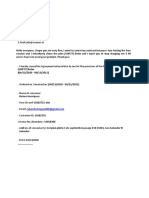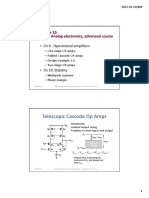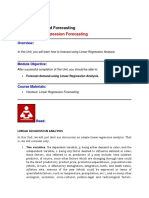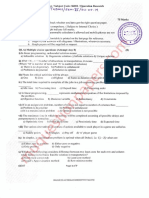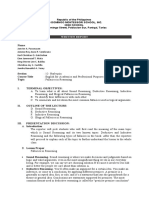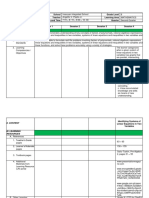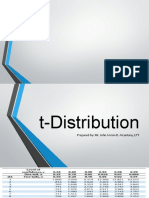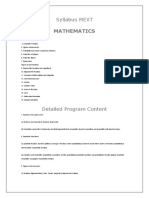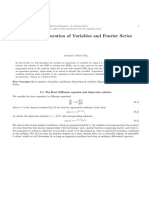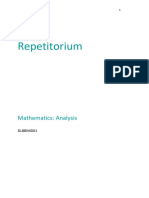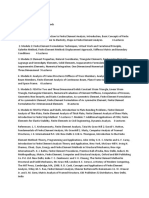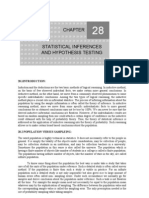Convolucion Ti89 PDF
Convolucion Ti89 PDF
Uploaded by
AlexandErHenríquezCopyright:
Available Formats
Convolucion Ti89 PDF
Convolucion Ti89 PDF
Uploaded by
AlexandErHenríquezOriginal Title
Copyright
Available Formats
Share this document
Did you find this document useful?
Is this content inappropriate?
Copyright:
Available Formats
Convolucion Ti89 PDF
Convolucion Ti89 PDF
Uploaded by
AlexandErHenríquezCopyright:
Available Formats
Features Used
<, when( ), NewProb,
Setup
1
C h a p t e r 7 NewFold conv
Convolution This chapter shows the convolution of two functions. To
simplify the details, the functions are finite, piecewise, and
continuous.
Topic 32: The Convolution Integral
Given a linear, time-invariant system with an impulse response of
t
h(t) = 2e 2 for t>0
h(t) = 0 for t < 0
find the output y(t) for the input function x(t) = 1 for 1<t<3 and zero elsewhere. y(t) is found by
solving the convolution integral
y( t ) = h() x( t )d
Topic 33: Piecewise Convolution
Both x(t) and h(t) are piecewise, continuous functions. That is, they are continuous everywhere
within sub-ranges and discontinuous only at the boundaries between subranges. As such, they can
be entered using the when function.
1. Clear the TI-89 by pressing 2 2:NewProb .
2. Enter the piecewise function for x1(t) as shown in
screen 1.
when( 1 2 t and t 2 3 b 1 b 0
d x1 c t d
The when function says x1(t) has the value 1 for 1<t<3
(1)
and the value 0 for all other values of t. x1(t) is used
instead of x since the TI-89 uses x when graphing.
1999 TEXAS INSTRUMENTS INCORPORATED
72 ELECTRICAL ENGINEERING APPLICATIONS WITH THE TI-89
3. Enter the piecewise function for h(t) as shown in
screen 2.
when( t 2 0 b 2 s 1 e 2 t d b 0 d
hctd
(2)
To be sure the functions are entered correctly, graph them.
This book follows the standard electrical engineering
convention of writing these as functions of time, t. The TI-89,
however, displays graphs as functions of x.
4. Enter h(t) and x1(t) in the Y= Editor as functions of x as
shown in screen 3. (3)
5. Set the plot ranges in the Window Editor as shown in
screen 4.
6. Press and set Grid to ON.
(4)
7. Press % to graph the functions (screen 5).
(5)
If you enter the convolution integral from Topic 32, an error
message is displayed as in screen 6. Therefore, the piecewise
integral must be divided into sub-ranges by hand.
(6)
Note: To enter the integral press 2
<. To enter press c ja.
(Save keystrokes by entering a
instead of .)
1. First, graph x(t-) versus .
To do this, pick a value for t, such as t=0, and enter it
on the Home screen (screen 7).
(7)
1999 TEXAS INSTRUMENTS INCORPORATED
CHAPTER 7: CONVOLUTION 73
2. Then define the functions in the Y= Editor as shown in
screen 8. Notice that y2(x) is deselected (use ) and y1(x)
and y3(x) are selected.
(8)
3. Press %.
y3(x) graphs a version of x1(t) that is flipped about the
y-axis. The graph for t=0 is shown in screen 9. x1(t) is
flipped so that its edges are at -3 and -1. For each value
of t>0 x1(t) is positioned further to the right.
(9)
4. Return to the Home screen and set t =0.5. Press
% to see the result (screen 10). Notice that for
t=0.5, x1(t) is closer to h(t).
(10)
5. Continue to consider the convolution integral for
various ranges of t. The following ranges are chosen so
that the integrals are easy to define.
Try a value of t1. From screen 10, the product of
x1(t-)h() is 0 since there are no values of t where both
functions are non-zero. Therefore, y(t) = 0 for t1.
6. Use a value of t such that 1< t <3. Set t to 1.5, and graph
the functions (screen 11).
(11)
1999 TEXAS INSTRUMENTS INCORPORATED
74 ELECTRICAL ENGINEERING APPLICATIONS WITH THE TI-89
For these values of t, the product of x1(t-)h() is non-zero over a range where there is some
overlap between the two functions. The convolution integral is now
y( t ) = h ( ) x ( t ) d
t 1
= 2e
0
2
(1)d
7. On the Home screen, use DelVar to delete the variable t
before doing the integral since it was previously set to
1.5. Then enter the integral as shown in screen 12.
2<2s1e2pcjadp1bc
jab0bt|1d
(12)
8. Once the integral is calculated, store the result in y4(x)
as shown in screen 13 so that it can be graphed in
Topic 34.
2 y4 c x d
(13)
Therefore, y(t) has the value shown in screen 12 for a
range of values of t. The graphs show that the overlap
starts when the t1 edge of x1(t) passed t=0. Therefore,
when t1>0, or when t>1, this form of y(t) is valid.
However, when the t3 edge of x1(t) passes t=0, the
integral takes on a different form. This form of y(t) is
valid when t3<0, or t<3. Therefore, this graph is valid
for 1<t<3.
9. Now use the range t >3. In this range, x1(t) lies
completely within h(t).
Set t = 3.5 on the Home screen. Then graph y1(x) and
y3(x) as shown in screen 14.
(14)
For this range, the integral is
y( t ) = h ( ) x ( t ) d
t 1
= 2e
t 3
2
(1)d
which is like the previous integral except the lower limit is changed.
1999 TEXAS INSTRUMENTS INCORPORATED
CHAPTER 7: CONVOLUTION 75
10. On the Home screen, use DelVar to delete t and then
enter the integral as shown in screen 15.
2<2s1e2pcjadp1bc
jabt|3bt|1d
11. Store the results in the variable y5(x) as shown in
(15)
screen 16 for plotting in Topic 34.
This is valid for t3>0, or t >3.
(16)
Topic 34: Graphing Piecewise Convolution Results
The output y(t) is given in three different pieces.
y(t) = 0 for t1
y(t) = 4e Nt/2(et/2 e1/2) for 1<t<3
y(t) = 4(e1) e1/2Nt/2 for t>3
1. Combine these using the when( ) function as shown in
screen 17.
when( t 2 1 b 0 b when( 1 2
t and t 2 3 b y4 c x d b y5 c x d d
d yy
(17)
2. In preparation for graphing yy, change all the ts in yy to
xs and save yy in y6(x) as in screen 18.
(18)
3. Press #. Use to deselect y1(x), y3(x), y4(x), and
y5(x) and select y2(x) and y6(x) (screen 19).
(19)
1999 TEXAS INSTRUMENTS INCORPORATED
76 ELECTRICAL ENGINEERING APPLICATIONS WITH THE TI-89
4. In the Window Editor, change the plot range on x so
that xmin is 0 and xmax is 6 as shown in screen 20.
(20)
5. Press % to see a graph of the convolution
integral as shown in screen 21.
The effects of the system on the input pulse x1(t) are clearly
seen in screen 21. The input pulse is amplified and smeared
or broadened as it passes through the system.
(21)
Tips and Generalizations
The when( ) function is a powerful feature of the TI-89 that allows piecewise functions to be
manipulated easily. Here, the three pieces of the solution to a piecewise convolution were
combined into a single function (yy), allowing it to be graphed as if it were a single continuous
function. The when( ) function can be used anytime a piecewise function is needed.
Sometimes a new function is built by defining pieces over different time intervals. Other times it is
better to define a function by adding sinusoids of different frequencies. In Chapter 8, the TI-89 will
be used to find the Fourier series coefficients of a signal and reconstruct that signal from some of
the coefficients.
1999 TEXAS INSTRUMENTS INCORPORATED
You might also like
- Signals and Systems: CE/EE301Document9 pagesSignals and Systems: CE/EE301Abdelrhman MahfouzNo ratings yet
- The - Transform: X 2z 4z 2zDocument56 pagesThe - Transform: X 2z 4z 2zOHNo ratings yet
- Determination of The State-Space Form of A Differential Equation & Solving It Using MATLAB's Ode45-SolverDocument4 pagesDetermination of The State-Space Form of A Differential Equation & Solving It Using MATLAB's Ode45-SolverDeepshikhaSinghNo ratings yet
- EENG 479: Digital Signal Processing: Student Name: IDDocument12 pagesEENG 479: Digital Signal Processing: Student Name: IDEbrahimNo ratings yet
- Haykin5 PDFDocument33 pagesHaykin5 PDFdhananjayan89100% (1)
- 1487251639EE 2017 - Session 1 (Kreatryx Solutions)Document40 pages1487251639EE 2017 - Session 1 (Kreatryx Solutions)Utkarsh RajNo ratings yet
- Lab 07 PDFDocument6 pagesLab 07 PDFAbdul Rehman AfzalNo ratings yet
- Fourier Analysis On Ti-89Document6 pagesFourier Analysis On Ti-89Jack KennedyNo ratings yet
- Control Systems Formula Sheet PDF FreeDocument12 pagesControl Systems Formula Sheet PDF FreeEidren 02No ratings yet
- Unit 3 Common Fourier Transforms Questions and Answers - Sanfoundry PDFDocument8 pagesUnit 3 Common Fourier Transforms Questions and Answers - Sanfoundry PDFzohaibNo ratings yet
- Practice Sheet-I Fuzzy LogicDocument10 pagesPractice Sheet-I Fuzzy LogicShifa H RahmanNo ratings yet
- Solved Problems PDFDocument7 pagesSolved Problems PDFKesuma Dewi AyuNo ratings yet
- Control Sol GA PDFDocument342 pagesControl Sol GA PDFRishabh ShuklaNo ratings yet
- Bode RulesDocument4 pagesBode RulesHafeth Dawbaa100% (1)
- Trapezoidal RuleDocument10 pagesTrapezoidal RuleRicardo Wan Aguero0% (1)
- Assignment 1Document3 pagesAssignment 1billy bobNo ratings yet
- Assignment 2b SolutionsDocument12 pagesAssignment 2b SolutionsvbweuhvbwNo ratings yet
- Assignment 2a SolutionsDocument17 pagesAssignment 2a SolutionsvbweuhvbwNo ratings yet
- Signal Generator Project StatementDocument16 pagesSignal Generator Project StatementHussain Bin AliNo ratings yet
- Chapter 2 NewDocument60 pagesChapter 2 NewSuhaila Ehab100% (2)
- Analog Signal Processing Tutorial 2: Sampling and ReconstructionDocument12 pagesAnalog Signal Processing Tutorial 2: Sampling and ReconstructionDuy Ngô Phạm ĐìnhNo ratings yet
- Matlab Code For KL AlgoDocument4 pagesMatlab Code For KL Algoarun14089100% (4)
- Lecture 16, 17 Steady-State Error For Unity Feedback SystemDocument29 pagesLecture 16, 17 Steady-State Error For Unity Feedback SystemHamza KhanNo ratings yet
- DSP QuestionsDocument2 pagesDSP Questionsveeramaniks408No ratings yet
- Elementary Signals: 1.1 Signals Described in Math FormDocument23 pagesElementary Signals: 1.1 Signals Described in Math FormChoirul Huda100% (1)
- High Gain ObserverDocument21 pagesHigh Gain ObserverGopakumarKodakkallingalNo ratings yet
- DSP Matlab ProgramsDocument18 pagesDSP Matlab ProgramsSanila CmNo ratings yet
- Unit - IVDocument56 pagesUnit - IVharikaranNo ratings yet
- Nyquist Stability CriterionDocument20 pagesNyquist Stability CriterionmoosuhaibNo ratings yet
- Akra, Bazzi - On The Solution of Linear Recurrence Equations PDFDocument16 pagesAkra, Bazzi - On The Solution of Linear Recurrence Equations PDFSHIVAM GUPTANo ratings yet
- Laplace Transform ExamplesDocument19 pagesLaplace Transform Exampleshamza abdo mohamoudNo ratings yet
- Impulse Response and Its Properties of Various LTI SystemsDocument5 pagesImpulse Response and Its Properties of Various LTI SystemsCangkang SainsNo ratings yet
- EE Lab Manuls Fast NuDocument83 pagesEE Lab Manuls Fast NuMuhammad SaadNo ratings yet
- Signals and Systems: CE/EE301Document12 pagesSignals and Systems: CE/EE301Abdelrhman MahfouzNo ratings yet
- Numerical Linear Algebra University of Edinburgh Past Paper 2020-2021Document4 pagesNumerical Linear Algebra University of Edinburgh Past Paper 2020-2021Jonathan Samuels100% (1)
- Z TransformDocument71 pagesZ TransformSmitha VasNo ratings yet
- Solution 2Document5 pagesSolution 2Paulina MarquezNo ratings yet
- Lab Manual 10: Z-Transform and Inverse Z-Transform Analysis ObjectiveDocument7 pagesLab Manual 10: Z-Transform and Inverse Z-Transform Analysis ObjectiveSyed Waqas ShahNo ratings yet
- Lab 05-Study of Systems Using MATLABDocument7 pagesLab 05-Study of Systems Using MATLABSobia ShakeelNo ratings yet
- Greens Theorem ProofDocument5 pagesGreens Theorem ProofGaurav DharNo ratings yet
- F X DT D: 1) Krasovskii's TheoremDocument51 pagesF X DT D: 1) Krasovskii's Theoremvenkat rajNo ratings yet
- EENG 223 Final Exam S08-09 SolnDocument7 pagesEENG 223 Final Exam S08-09 SolnFredy AlbornozNo ratings yet
- DSP Çikmiş SorularDocument29 pagesDSP Çikmiş Sorularbedirhandurmus7No ratings yet
- Bode Plot Chapter 5Document31 pagesBode Plot Chapter 5Ahmed SaidNo ratings yet
- Lab 7 FM POCDocument7 pagesLab 7 FM POCSPARK LIGHTSNo ratings yet
- DSP Lab Report # 04Document23 pagesDSP Lab Report # 04Abdul BasitNo ratings yet
- Nyquist Stability CriterionDocument4 pagesNyquist Stability CriterionRajeev KumarNo ratings yet
- Exam 1Document108 pagesExam 1ManikaushikNo ratings yet
- SignalsDocument47 pagesSignalsrohith100% (1)
- 92402Document34 pages92402anon_1937750530% (1)
- DSP Lab Sheet 2 PDFDocument50 pagesDSP Lab Sheet 2 PDFSreekrishna DasNo ratings yet
- Introduction To Switched-Mode Converter Modeling Using MATLAB/SimulinkDocument37 pagesIntroduction To Switched-Mode Converter Modeling Using MATLAB/SimulinkAhana MalhotraNo ratings yet
- Lec 33 - Householder MethodDocument11 pagesLec 33 - Householder MethodMudit Sinha100% (1)
- Applications of Laplace Transform Unit Step Functions and Dirac Delta FunctionsDocument8 pagesApplications of Laplace Transform Unit Step Functions and Dirac Delta FunctionsJASH MATHEWNo ratings yet
- IC6701 May 18 With KeyDocument14 pagesIC6701 May 18 With KeyAnonymous yO7rcec6vuNo ratings yet
- Convolution: Topic 32: The Convolution IntegralDocument6 pagesConvolution: Topic 32: The Convolution IntegralAlexandErHenríquezNo ratings yet
- Convolucion Con Ti89, y Voyage 200Document6 pagesConvolucion Con Ti89, y Voyage 200Patricio CortesNo ratings yet
- Transmission Lines: Topic 56: Characteristic ImpedanceDocument10 pagesTransmission Lines: Topic 56: Characteristic ImpedanceRenesiy Marco NovillaNo ratings yet
- Proj2 ControlDocument5 pagesProj2 ControlBarak HenenNo ratings yet
- Parametric Equations of ConicsDocument8 pagesParametric Equations of Conics78danielNo ratings yet
- A Reformulation of USGS Volumetric "Heat in Place" Resource Estimation Method Sabodh Garg Combs PDFDocument9 pagesA Reformulation of USGS Volumetric "Heat in Place" Resource Estimation Method Sabodh Garg Combs PDFAlexandErHenríquezNo ratings yet
- Muster Widerrufsformular PDFDocument1 pageMuster Widerrufsformular PDFAlexandErHenríquezNo ratings yet
- Telescopic Cascode Op Amps: - CH 9 Operational AmplifiersDocument8 pagesTelescopic Cascode Op Amps: - CH 9 Operational AmplifiersAlexandErHenríquezNo ratings yet
- Miller EffectDocument8 pagesMiller EffectAlexandErHenríquezNo ratings yet
- Convolution: Topic 32: The Convolution IntegralDocument6 pagesConvolution: Topic 32: The Convolution IntegralAlexandErHenríquezNo ratings yet
- Topic - 03 - (Helmholtz' Theorem) PDFDocument12 pagesTopic - 03 - (Helmholtz' Theorem) PDFAntriksha VishwakarmaNo ratings yet
- Module 3: Demand Forecasting: Unit 5: Linear Regression ForecastingDocument9 pagesModule 3: Demand Forecasting: Unit 5: Linear Regression ForecastingAshly Kate AbarientosNo ratings yet
- Tybms Sem6 or Nov19Document7 pagesTybms Sem6 or Nov19miracle worldNo ratings yet
- Example of Thesis Title of Computer ScienceDocument5 pagesExample of Thesis Title of Computer SciencePayForAPaperBuffalo100% (2)
- ElektroDocument2 pagesElektroRaigaNo ratings yet
- Lec - 2 - Analysis of Algorithms (Part 2)Document45 pagesLec - 2 - Analysis of Algorithms (Part 2)Ifat NixNo ratings yet
- Iv. AssignmentDocument4 pagesIv. AssignmentIisha karmela AldayNo ratings yet
- Group 1 Eapp Written ReportDocument3 pagesGroup 1 Eapp Written ReportJanvier PacunayenNo ratings yet
- Conversation Analysis and A Cultural-Historical Approach: Comparing Research Perspectives On Children's StorytellingsDocument389 pagesConversation Analysis and A Cultural-Historical Approach: Comparing Research Perspectives On Children's Storytellingsmaton85848No ratings yet
- 18.1 Second-Order Euler EquationsDocument14 pages18.1 Second-Order Euler EquationsMunir AslamNo ratings yet
- CV Subhajit D.ADocument3 pagesCV Subhajit D.Apan.bharatbhushanNo ratings yet
- Simultaneous Estimation of Mefenamic Acid and Hyoscine-N-Butyl Bromide by Novel RP-HPLC Method in Bulk and Pharmaceutical Dosage FormDocument10 pagesSimultaneous Estimation of Mefenamic Acid and Hyoscine-N-Butyl Bromide by Novel RP-HPLC Method in Bulk and Pharmaceutical Dosage FormBaru Chandrasekhar RaoNo ratings yet
- Week 1Document9 pagesWeek 1Angelito PepitoNo ratings yet
- RPN Synthesis Using FEADocument8 pagesRPN Synthesis Using FEAyatinNo ratings yet
- T DistributionDocument33 pagesT DistributionJj Delloro100% (2)
- Syllabus MEXT: MathematicsDocument4 pagesSyllabus MEXT: Mathematicswh at100% (1)
- Shown.: Example: Determine The Vertical and Horizontal Deflections at The Point B of The TrussDocument3 pagesShown.: Example: Determine The Vertical and Horizontal Deflections at The Point B of The TrussNitin rajputNo ratings yet
- Section2 Group7 Id Case AnalysisDocument3 pagesSection2 Group7 Id Case AnalysisSUDHAKAR SHARMANo ratings yet
- Chapter-4: Adrien Marie Legendre (1752-1833), A French Mathematician, Who IsDocument28 pagesChapter-4: Adrien Marie Legendre (1752-1833), A French Mathematician, Who IsHabuwaka MoyamesiNo ratings yet
- M257 316 2012 Lecture 9 PDFDocument4 pagesM257 316 2012 Lecture 9 PDFsalmanNo ratings yet
- Geometric SequencesDocument5 pagesGeometric SequencesMarvin DizonNo ratings yet
- DLBDSMFC01 Repetitorium Draft VersionDocument103 pagesDLBDSMFC01 Repetitorium Draft VersiongancorvicNo ratings yet
- MST562 Lecture 16 - Renewal Processes (Student)Document11 pagesMST562 Lecture 16 - Renewal Processes (Student)Hajar Nur HumairaNo ratings yet
- Cbot-Unit 1-LPPDocument23 pagesCbot-Unit 1-LPPJaya SuryaNo ratings yet
- Milkfish Bones Luncheon Meat Pork Luncheon MeatDocument3 pagesMilkfish Bones Luncheon Meat Pork Luncheon MeatSarah KinkitoNo ratings yet
- CH 2Document19 pagesCH 2Gizaw BelayNo ratings yet
- 7 Ce 159Document1 page7 Ce 159ashwaNo ratings yet
- Research Methodology Syllabus For PHD Course WorkDocument7 pagesResearch Methodology Syllabus For PHD Course Workf675ztsf100% (3)
- S28 Statistical Inferences & Hypothesis Testing (NEW)Document95 pagesS28 Statistical Inferences & Hypothesis Testing (NEW)Abilash ReddyNo ratings yet










